The AMT Bridle™
The Comfortable Alternative for Nasal Tube Securement
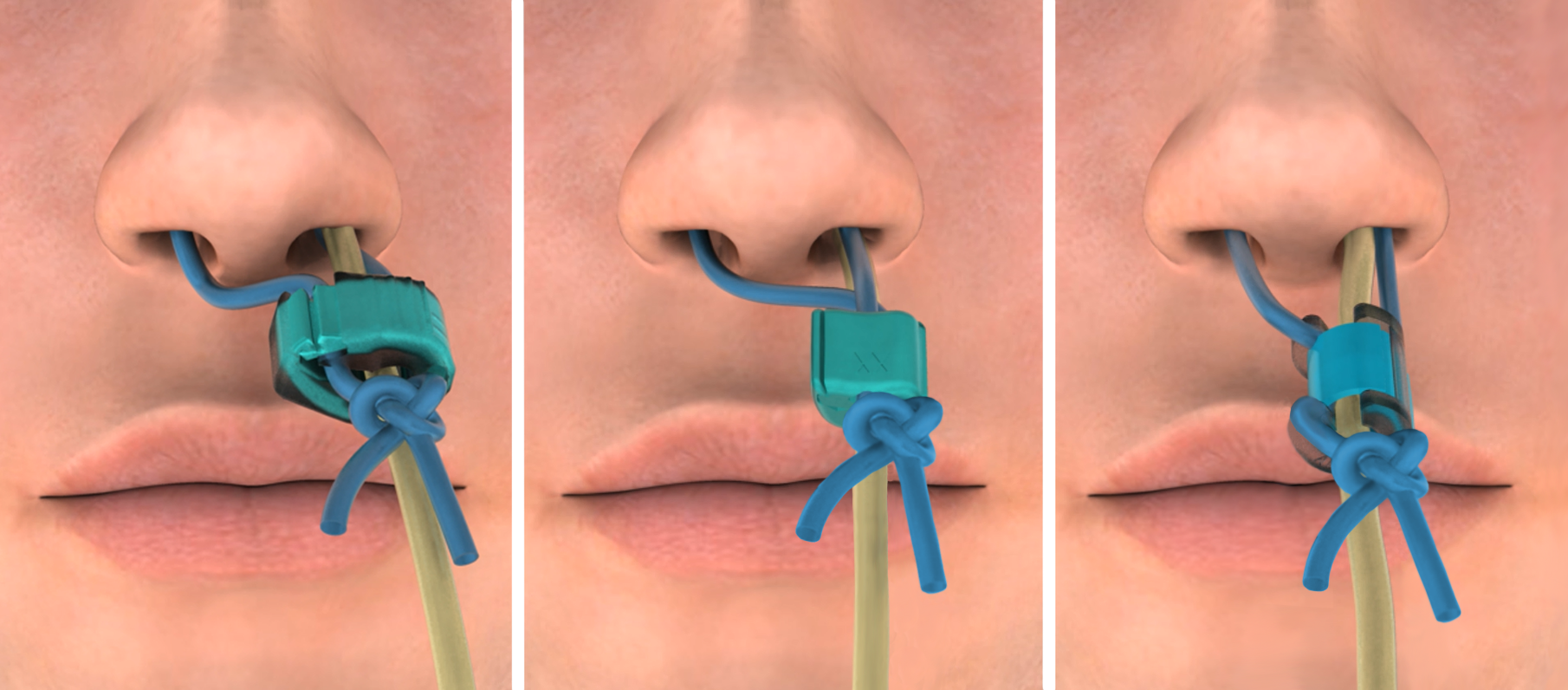
What is a Nasal Bridle?
A nasal bridle is a securement method used to discourage patients, young or old, from pulling on their nasoenteric feeding tube. Reports show that 40 percent of nasogastric feeding tubes are dislodged, which may lead to the unnecessary surgical placement of a feeding device or conversion to parenteral nutrition support.* A nasal bridle is an effective and safe way to secure a patient’s nasal tube, retaining the nutrition flow to the patient.
*Seder CW, Janczy R. The Routine Bridling of Nasojejunal Tubes is a Safe and Effective Method of Reducing Dislodgement in the Intensive Care Unit. NCP Nutrition in Clinical Practice. 2008-2009:23(6) 651-654
What does it look like?: The nasal bridle system has several distinct pieces; a blue retrieval probe, a catheter with removable safety stylet and blue bridle tubing, a pre-attached clip, a removal tool, and a lubricant packet. Most of these components serve to thread the bridle into place within the nasopharynx. Once properly inserted, only the soft bridle tubing and device clip remain. The other pieces are discarded.
Improving nutritional outcomes while reducing nasal tube pullout costs!
The AMT Bridle™ Family has been shown to:
*Gunn SR, Early BJ, Zenati MS, Ochoa JB: Use of a Nasal Tube Bridle Prevents Accidental Nasoenteral Feeding Tube Removal. JPEN Journal of Parenteral and Enteral Nutrition 2009: 33(1): 50-54
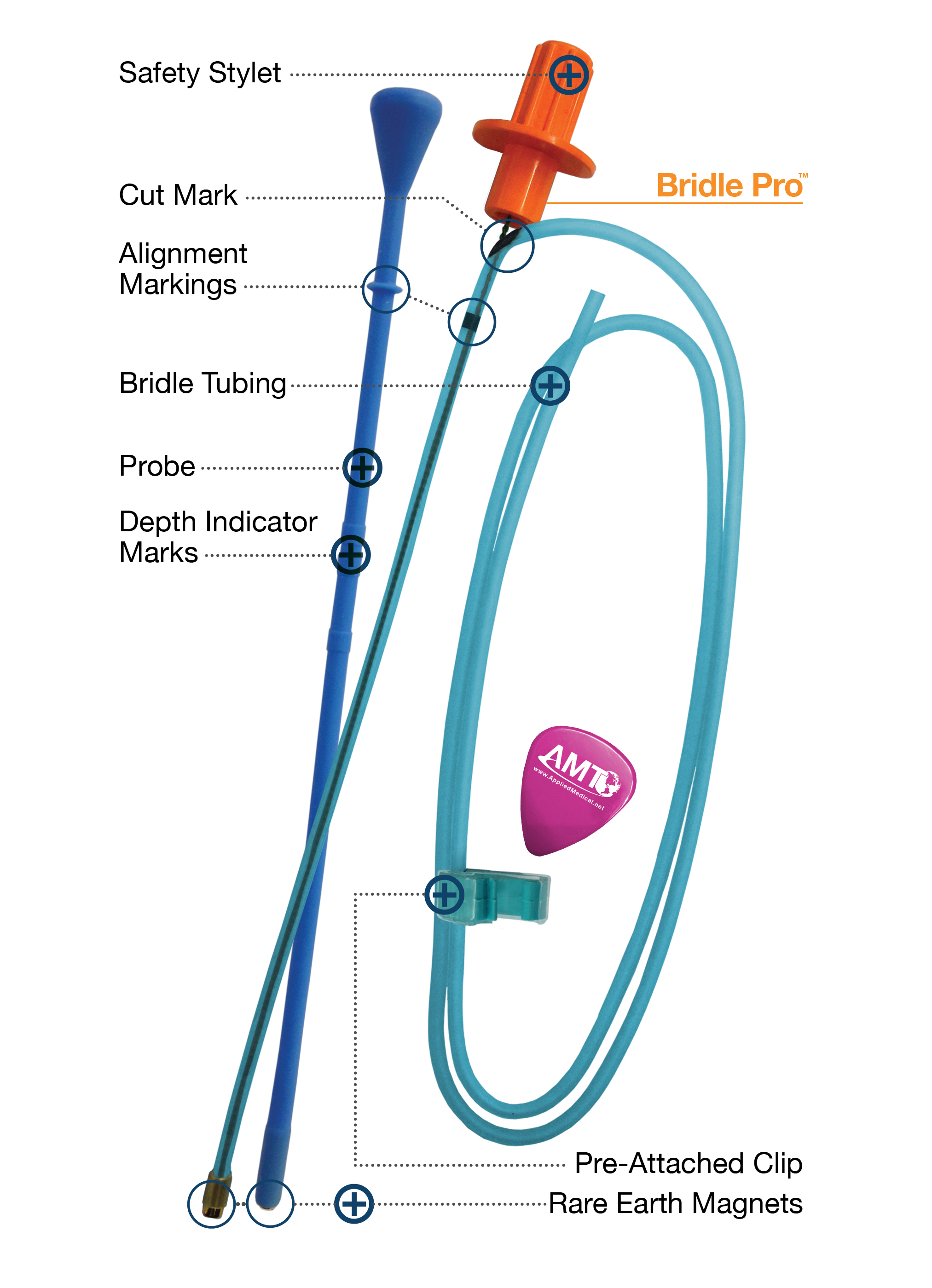
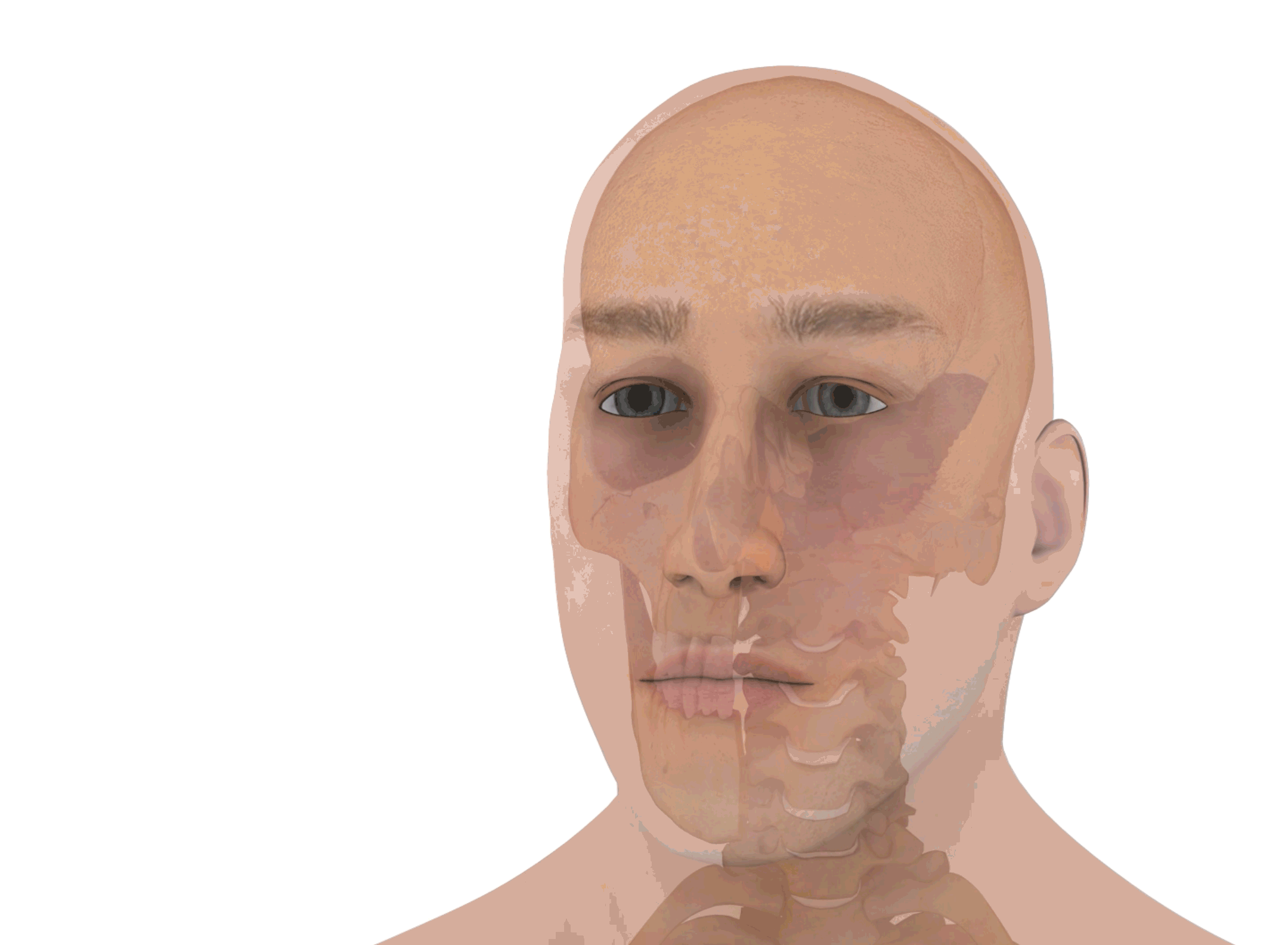
How Does a Nasal Bridle Work?
The retrieval probe is inserted into the nostril without a nasal tube. The catheter with safety stylet and bridle tubing is inserted into the opposite nostril. Both the probe and stylet are advanced towards the back of the nasal septum where the two magnets will connect around the vomer bone inside the nasal cavity. The magnets allow the two pieces to unite creating the bridle loop with bridle tubing.
Once the bridle loop has been established, slide the pre-attached clip up the bridle tubing to approximately 1cm or one finger width from the nostril, and just above the lip. Then, place the nasal tube into the clip’s defined nasal tube region. From there, take the loose strands of bridle tubing, place them within the clip, and close the clip. Once the clip is closed, tie the two strands of bridle catheter together into a simple knot below the clip, and cut the excess 1cm below the knot, securing the nasal tube.
Once the bridle tubing is passed through both nostrils and around the vomer bone, it uses the structure of the nasal cavity to hold the feeding tube in place.
Clinically Proven for Both Pediatrics and Adults
Routine bridling has become the standard of care for many ICUs due to improved nutritional outcomes and cost management. Rather than restrict bridling to suspected “problem” patients, the cost savings should result in universal use on all nasal tubes: Every Tube, Every Time!

“The AMT Bridle novel technique offers relatively easy and quick placement without sedation.”
“We conclude that bridling of nasoenteric feeding tubes provides a safe and effective method of decreasing unintended tube dislodgement and optimizing nutritional delivery in [pediatric] patients.”
- Newton LE, Abdessalam SF, Raynor SC, Lyden ER, Cusick RA (2016) Stabilization of Nasoenteric Feeding Tubes Using Nasal Bridles In Paediatric Patients. Matern Pediatr Nutr 2:111. doi: 10.4172/2472-1182.1000111
The Importance of the AMT Bridle™ Family
The AMT Bridle™ system dramatically reduces feeding tube pullouts, resulting in an improved caloric intake. It is critical to maintain nasal tube securement in the neonatal and pediatric populations to ensure essential nutrition delivery to their growing bodies and avoid unnecessary nasal tube replacements. Conventional methods of tube securement using tape often lead to premature pullouts, dislodgement, and skin breakdown.
For pediatric patients, AMT recommends placing the Bridle device prior to any nasal tubes.

Risks of Securement with the Alternative Method:
- Marginal adhesive effectiveness
- Skin breakdown
- Dislodgement of nasal tube
- Allergic reaction due to adhesive
- Nasal septal damage
Inadequately secured nasal tubes expose patients to risks including:
- Aspiration
- Pneumothorax
- Radiographic exposure
- Early and unnecessary transition to PEG/TPN
- Sinusitis
- Pressure necrosis
- Interruptions to nutritional support
- More frequent replacement procedure
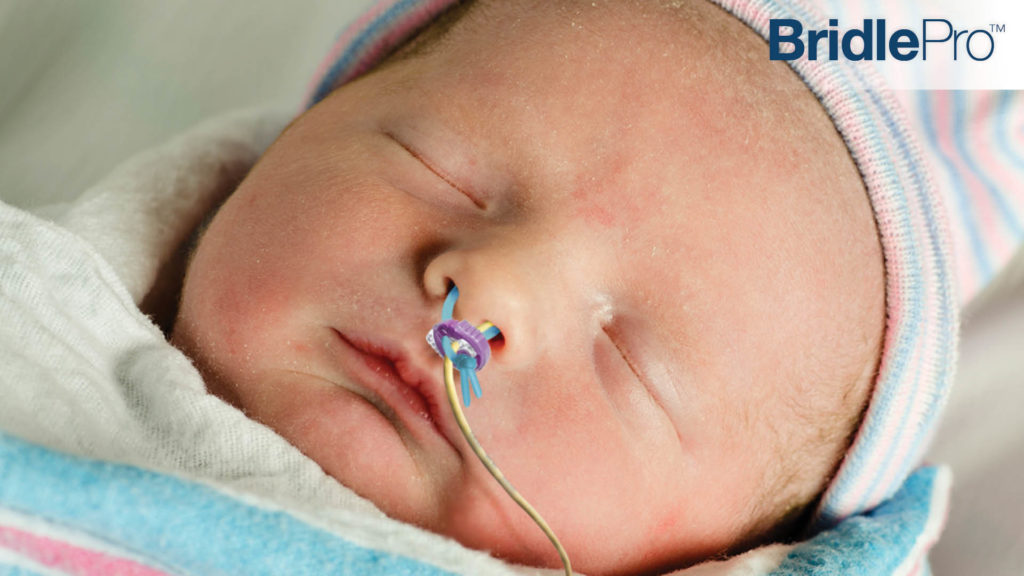
Benefits of the Bridle Family Securement Method:
- FDA Cleared for pediatric use
- FDA Cleared for use with ANY brand of nasal tube
- Available in sizes to secure nasal tubes as small as 5F
- MR safe after proper placement
- No patient sedation required
The Bridle Family of Devices is a safety device:
- Specifically designed by a physician
- Manufactured by AMT, the inventors of the AMT Bridle™ technology
- AMT has over 15 years of bridling product experience
- Device secures around the strong vomer bone
- Device strength and retention designed for patient safety
- All device components will release or break well below the amount of force needed to cause injury
What is the Vomer Bone?
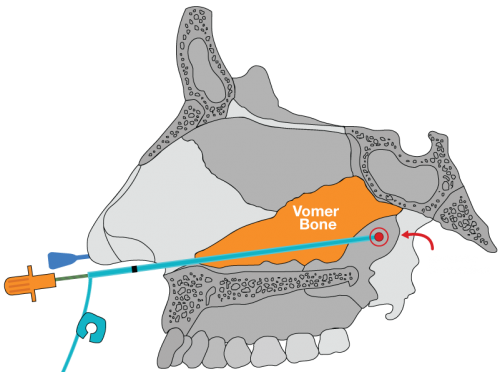
The nasal bridle is kept in place by the vomer bone, a mid-skull bone forming part of the nasal septum.
The vomer bone begins formation at eight weeks gestation, is fully formed as a bone by 18.5 weeks gestation, and is ossified at birth. This allows patients of all ages to be safely bridled.
Patient safety and comfort are a top priority for AMT and this cranial structure is a great securement location for nasal tubes. Once the Bridle Pro® is properly placed, no tape or sutures are required to keep the nasal tube secured, allowing for patients to be more comfortable.
Bridle Pro® Innovations
There are several new elements to the Bridle Pro® system: Pro Range Clips, Pro Clips, and Blue Bridle Tubing.
Pro Range Clips:
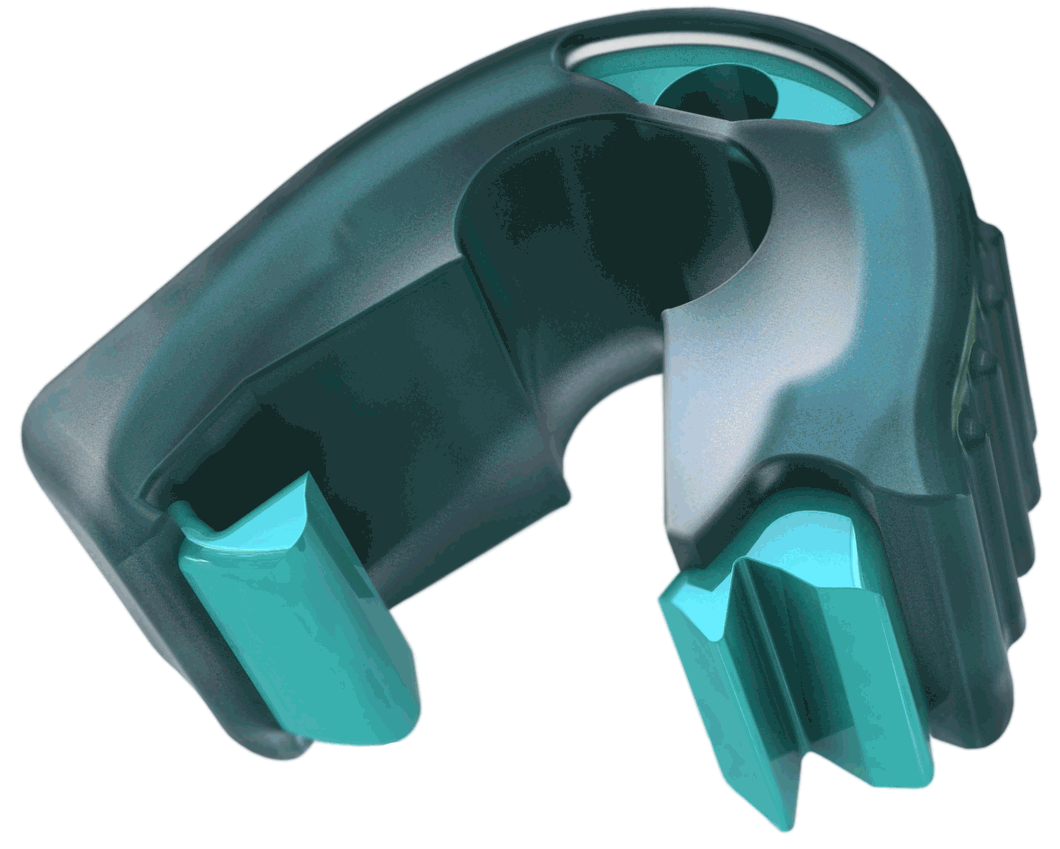
Pro Clips:
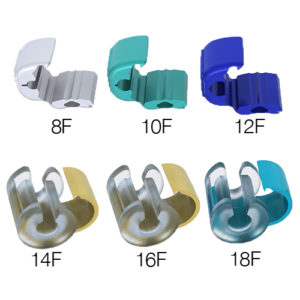
Blue Bridle Tubing:
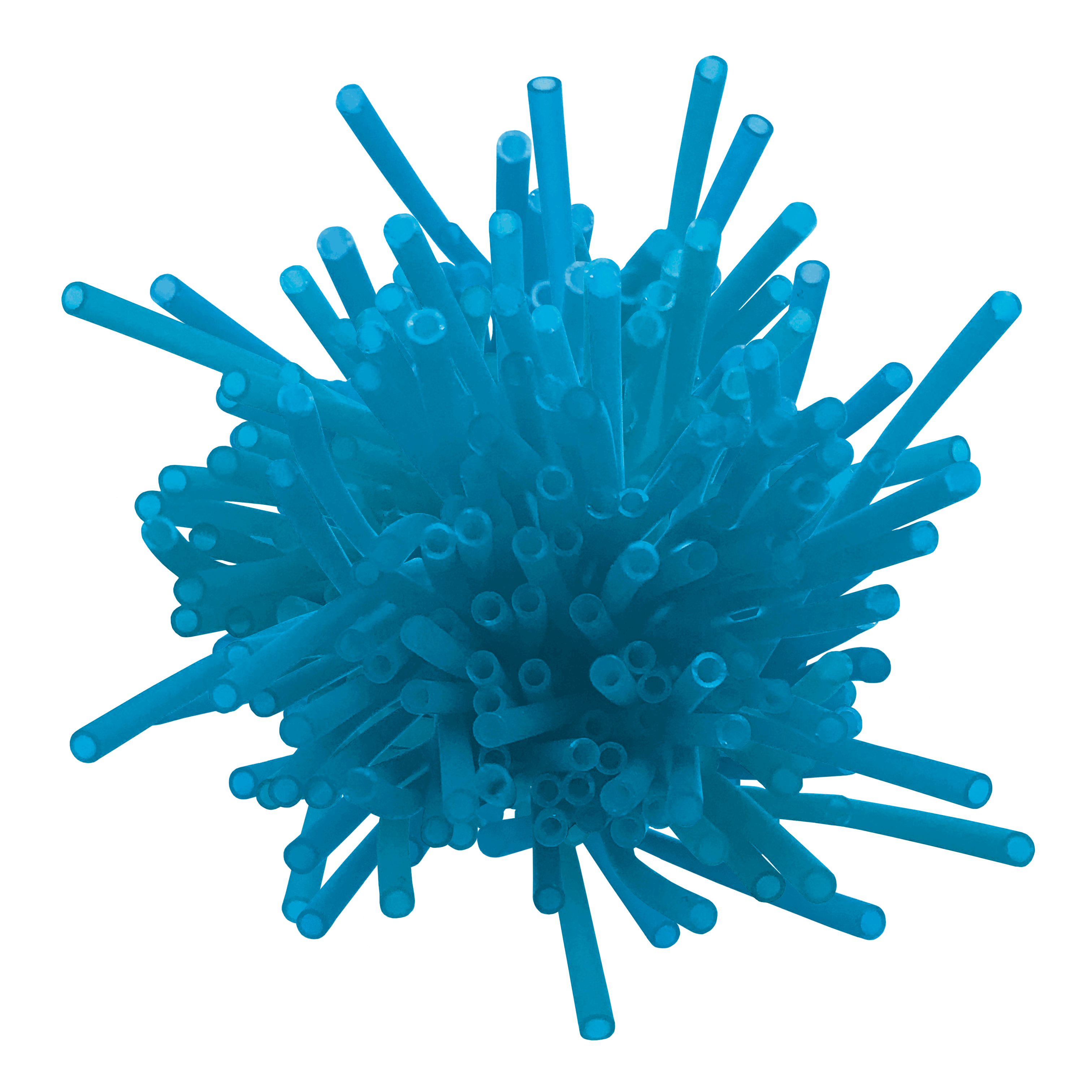
AMT Bridle Pro® Educational Video
The AMT Bridle™ Family is easily placed by passing magnets within the nasopharynx, which allows the bridle tubing to be looped around the vomer bone, and then anchored to the tube with a clip.
Quick Reference Guide for the AMT Bridle Pro® System

The AMT Bridle Pro® is easily placed using magnets to draw bridle tubing through the nasopharynx; in one nare, around the vomer bone, and out the other nare, then securing it to the nasal tube with a French Size specific clip. AMT has provided this information as an educational resource. Do not attempt to use the AMT Bridle Pro® without also reviewing the product’s complete Directions for Use (DFU/IFU).
Part Numbers & Ordering Information
AMT Bridle Pro®
The Bridle Pro® system consists of a retrieval probe, a flexible monofilament bridle catheter (bridle tubing) which houses a removable stylet guide, a pre-attached clip, a clip opening device, and a packet of water-soluble lubricant.
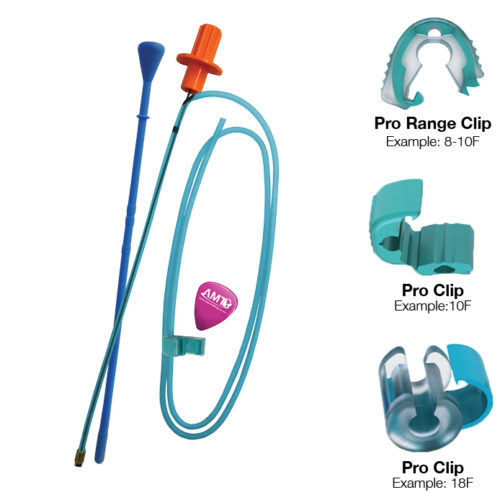
| Description | Order # | Box Qty |
| 5F-6F Pediatric Bridle Pro® Range (Purple) | 4-420506P | 5 |
| 8F-10F Pediatric Bridle Pro® Range (Teal) | 4-420810P | 5 |
| 8F Pediatric Bridle Pro® (White) | 4-4208P | 5 |
| 8F-10F Bridle Pro® Range (Teal) | 4-420810 | 5 |
| 12F-14F Bridle Pro® Range (Dark Blue) | 4-421214 | 5 |
| 16F-18F Bridle Pro® Range (Yellow) | 4-421618 | 5 |
| 8F Bridle Pro® (White) | 4-4208 | 5 |
| 10F Bridle Pro® (Teal) | 4-4210 | 5 |
| 12F Bridle Pro® (Dark Blue) | 4-4212 | 5 |
| 14F Bridle Pro® (Yellow) | 4-4214 | 5 |
| 16F Bridle Pro® (Yellow) | 4-4216 | 5 |
| 18F Bridle Pro® (Light Blue) | 4-4218 | 5 |
| Description | Order # | Box Qty |
| 5F-6F Bridle Pro® Range Clip (Purple) | 4-460506 | 5 |
| 8F-10F Bridle Pro® Range Clip (Teal) | 4-460810 | 5 |
| 12F-14F Bridle Pro® Range Clip (Dark Blue) | 4-461214 | 5 |
| 16F-18F Bridle Pro® Range Clip (Yellow) | 4-461618 | 5 |
| 8F Bridle Pro® Clip (White) | 4-4608 | 5 |
| 10F Bridle Pro® Clip (Teal) | 4-4610 | 5 |
| 12F Bridle Pro® Clip (Dark Blue) | 4-4612 | 5 |
| 14F Bridle Pro® Clip (Yellow) | 4-4614 | 5 |
| 16F Bridle Pro® Clip (Yellow) | 4-4616 | 5 |
| 18F Bridle Pro® Clip (Light Blue) | 4-4618 | 5 |
Frequently Asked Questions
AMT has provided this information as an educational resource tool. This is not intended as a substitute for professional medical care. Your FIRST source of information should be your healthcare provider.
WHAT ARE THE MAIN DIFFERENCES BETWEEN THE BRIDLE PRO RANGE CLIPS AND BRIDLE PRO CLIPS
Bridle Pro Range Clips
- Available in 5-6F, 8-10F, 12-14F, and 16-18F (can accommodate more than one French size)
- Pre-attached to blue bridle tubing
Bridle Pro Clips
- Available in 8, 10, 12, 14, 16, and 18F (French size specific clips)
- Pre-attached to blue bridle tubing
CAN THE AMT BRIDLE FAMILY OF DEVICES BE USED WITH PEDIATRIC PATIENTS?
Absolutely, the AMT family of nasal tube retaining devices are FDA cleared for both pediatric and adult patients. They are also cleared for use with any brand of nasal tube.
HOW DOES THE AMT BRIDLE FAMILY OF DEVICES SAVE MONEY FOR THE PATIENT AND HOSPITAL?
OPTIMAL NUTRITION – OPTIMAL RECOVERY – It is generally believed that early, aggressive enteral feeding facilitates faster patient healing with a resultant decrease in ICU and hospital stays. Use of the AMT Bridle Family of Devices minimizes interruption of tube feedings, enhancing patient nutrition and lowering healthcare costs.
SAVINGS ON TUBES, X-RAYS, AND NURSING TIME – Use of the AMT Bridle Family System results in significant cost savings. A study conducted at the University of Pittsburgh Medical Center estimated that using the Bridle for all their tubes (1440 per year) would result in 275 fewer tubes, 330 fewer X-Rays, and 45 fewer nurse days (Gunn, et. al., JPEN Vol 33, Feb 2009).
SAVINGS ON ENTERAL NUTRITION FORMULA – If a tube is pulled out, replacement can take several hours which can result in the need to discard expensive enteral nutrition formula. Use of the Bridle dramatically reduces pull-outs, so waste is also minimized.
SAVINGS ON STAFF TIME AND LAUNDRY COST – If a tube is pulled completely out, the formula is pumped onto the patient’s bed. The result is a messy cleanup which wastes staff time and adds to laundry costs. Bridling prevents most pull outs so these expenses are avoided.
APPROXIMATE COST ANALYSIS: COST OF REPLACING 1 FEEDING TUBE*
- Cost of Feeding Tube: $26.00
- Cost of X-Ray: $340.00
- Cost of Radiologist Read: $35.00
- Cost of Nursing Time: $28.00
- Approximate Total Cost: $429.00
- Approximate cost to replace 2 feeding tubes: $858.00
- Approximate cost to replace 3 feeding tubes: $1,287.00
*Information taken from multiple sources
IS THERE AN INCREASED RISK OF INFECTION OR SINUSITIS WITH THE AMT BRIDLE FAMILY OF DEVICES?
To date, hundreds of thousands of AMT Bridles have been placed in hundreds of institutions with no documented increase in incidents of sinusitis associated with the AMT Bridle Family of Devices.
WILL THE AMT BRIDLE FAMILY OF DEVICES DAMAGE THE NASAL SEPTUM?
All tubes passing through the nasal cavity can irritate the nasal mucosa.
The Bridle Pro™ bridle tubing is very soft and was designed with patient comfort in mind. No lubricant is needed while placing the Bridle Pro™ device due to the soft and smooth material, however, lubricant may be used if desired.
WHAT HAPPENS IF THE PATIENT PULLS ON THE BRIDLE DEVICES?
If a patient pulls on a tube secured with Bridle Pro™, they will create pressure on the vomer bone at the back of the nasal septum/vomer bone, which will cause discomfort. This negative reinforcement will deter most patients from pulling further. Despite this, some patients will continue to pull. The increased force on the tube will cause the outside diameter of the feeding tube to narrow and slip through the clip before damage occurs to the vomer bone at the back of the nasal septum.
HOW LONG CAN THE BRIDLE DEVICES STAY IN PLACE?
The Bridle Pro™ is FDA-cleared for 30 days of continuous use.
WHY SHOULDN'T I USE A ``HOMEMADE`` BRIDLE?
SAFETY – The Bridle Pro™ clips are designed to allow some slipping, should a patient pull so hard that they might hurt themselves. To date, hundreds of thousands of AMT Bridles have been placed. For the user, you have the assurance that you are working with a clinically proven, FDA-cleared product.
PATIENT COMFORT – The magnetic retrieval system allows for a gag-free interface with the patient, as you are not reaching into their mouth, unlike homemade techniques.
TIME SAVINGS – The Bridle Pro™ can be placed in under a minute. In the event of unintentional dislodgement or migration, the Bridle can save hours in reinsertion time.
OPTIMAL MATERIALS – All materials used in the AMT Bridle Family of Devices have been specifically chosen to optimize performance and safety.
WHY CAN'T THE AMT BRIDLE SYSTEMS BE RE-USED?
The Bridle Pro™ is designed to be a single-use disposable product.
WILL THE AMT BRIDLE SYSTEM MAGNETS DISTURB A PACEMAKER?
The rare earth magnets within the Bridle Pro™ are used only to create the loop around the vomer and do not stay in place. Once the device is placed, the magnet sections of the Bridle devices are to be discarded and not kept with the patient. For added safety of patients with pacemakers, it is recommended to keep the magnets near the placement site (patient’s head and neck area).
IS THE AMT BRIDLE FAMILY OF DEVICES MR SAFE?
Yes – the main portion of the kit, the probe and bridle catheter, have tiny but powerful magnets at their tips and are integral to making the connection between the two pieces. However, after proper placement, the Bridle Pro™ is MR safe.
Do not attempt to use the Bridle Pro™ without also reviewing the product’s complete Directions for Use (DFU).
